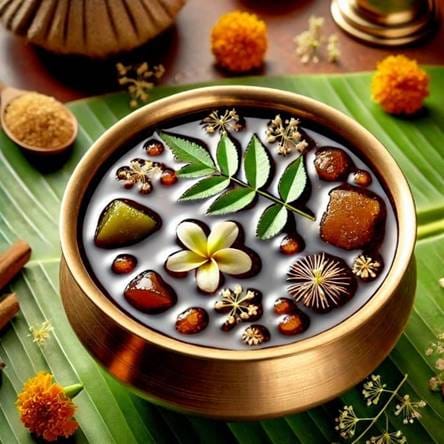
The Ugadi festival marks the Hindu New Year in Karnataka, Telangana, and Andhra Pradesh. This auspicious day carries deep mythological significance as Lord Brahma began creating the universe. Hindu traditions celebrate this festival on different dates each year based on the lunar calendar.
This festival holds a special place in people's hearts through its blend of meaningful customs and joyful celebrations. The iconic Ugadi pachadi's six tastes symbolize life's emotions, while homes sparkle with decorations weeks before the big day.
Understanding Ugadi: The Hindu New Year
The Sanskrit roots of "Ugadi" tell us a story - "yuga" means era and "adi" means beginning, which together mean "the beginning of a new age". This ancient festival marks the first day of Chaitra, a Hindu lunisolar calendar month. Millions of people in southern India celebrate it as a time of fresh starts and renewal.
What Ugadi means and its significance
Ugadi plays a vital role in Hindu traditions, both culturally and spiritually. The festival goes beyond marking time on a calendar. Many texts tell us that Lord Brahma started creating the universe on this special day . The 12th-century Indian mathematician Bhaskaracharya recognized Ugadi as the start of a new year, month, and day.
This festival means more than just mythology. Yes, it is nature's way of showing its cycles, as it comes right when spring begins and days become longer and brighter. The change in seasons stands for hope, growth, and prosperity after the harsh winter months.
The connection to the Aries constellation
Two calendar systems shape Ugadi celebrations. People usually follow the Chandramana (lunar) calendar to decide the Ugadi date. The Souramana (solar) calendar sets Ugadi when the sun moves into the Aries constellation.
Looking at it from an astronomical view, Ugadi used to line up with the Sun reaching the First Point of Aries - the March Equinox. Earth's axial precession (the precession of the Equinox) has moved this point into Pisces, which changed the celebrations too.
Our planet's tilt lets the northern hemisphere get the most solar energy during the 21 days after Ugadi. This charges Earth's batteries, even though we might feel uncomfortable in the heat .
How Ugadi is different from Gudi Padwa
Ugadi and Gudi Padwa happen on the same day but have their own special regional identity. Ugadi belongs to Karnataka, Telangana, and Andhra Pradesh, while people celebrate Gudi Padwa in Maharashtra and Goa.
Each festival has its unique customs. Gudi Padwa's families create a special "gudi" flag. They attach a silk scarf to a bamboo stick with neem leaves, mango flowers, and an upturned metal pot that stands for victory. Ugadi celebrations focus on making pachadi, a symbolic dish that combines six different flavors. Both festivals celebrate new beginnings but do it in their own special ways through local traditions.
When is Ugadi celebrated
Ugadi is celebrated on Pratipada Tithi (first lunar day).
Hindu festivals follow the lunisolar calendar, so Ugadi's date changes every year on the Gregorian calendar. People usually celebrate it in late March or early April. The date moves because it follows natural astronomical cycles instead of fixed calendar dates.
The festival takes place on the first day of the waxing moon after the first new moon following the March Equinox. This creates a beautiful connection between Earth's position, moon phases, and human celebrations.
Preparing Your Home for Ugadi
Families start their Ugadi preparations weeks before the Hindu New Year. They clean and decorate their homes to welcome the festival with purity and positive energy. This special time means both physical cleaning and spiritual renewal for households getting ready for this auspicious celebration.
Traditional cleaning rituals
A ritual called "spring cleaning" kicks off about a week before Ugadi. Families whitewash their walls, clear out every corner, and clean their cupboards and drawers completely.
People in traditional communities use fresh cow dung to sprinkle the ground in front of their houses. Cow dung works as a natural disinfectant that kills germs and keeps homes safe. This cleansing helps remove any negative elements from the previous year and creates room for positive energy to flow into homes.
Entrance decoration with mango leaves
The home decoration begins after the cleaning is done. Families hang "torana" - beautiful strings of mango leaves across their doorways. These green garlands need careful crafting as each leaf gets threaded together.
Mango leaves mean more than just decoration in this tradition. They stand for prosperity, good harvests, and overall well-being. These leaves keep negative energies away from homes and bring good fortune. Some families add neem leaves to their torana designs that make them powerful symbols of protection and purity.
Creating meaningful rangoli designs

Rangoli patterns play a key role in Ugadi preparations. Families draw these detailed designs outside their homes with geometric shapes, flowers, or religious symbols.
Rice flour, powdered limestone, colored sand, and flower petals come together in Ugadi-specific rangoli. Many designs show mango patterns or symbols of fresh starts. The limestone in traditional rangoli serves a practical purpose too - it helps keep insects away from the house.
Setting up the pooja area
The pooja room gets extra care before Ugadi. Families polish their deity idols and arrange the sacred space with care.
A decorated bronze or steel pot sits in front of the idols, topped with coconut and mango leaves. Fresh jasmine flowers fill the pooja area with their sweet smell. This thoughtful arrangement creates a perfect space for prayer and reflection as families prepare to welcome the new year's blessings through their rituals and offerings.
Essential Ugadi Rituals and Practices
Ugadi brings families together through sacred rituals that they perform with deep faith. These age-old practices change an ordinary day into a spiritually meaningful celebration that connects homes to traditions marking the beginning of the Telugu New Year.
Morning bathing customs
The Ugadi day starts before sunrise with "Abhyanga Snanam" - a ritual oil bath that cleanses both body and spirit. Family members wake up early to massage their bodies with sesame oil. This practice washes away past misdeeds and symbolizes spiritual renewal central to the ugadi festival. People prepare themselves for the day's sacred activities. Many regions in Andhra Pradesh add neem leaves to their bath water to enhance the purifying effects.
Ugadi pooja step-by-step guide

The ugadi pooja flows in a well-laid-out sequence:
1. Abhisheka - Sacred mantras accompany the bathing of deity idols
2. Alankara - Fresh flowers and new clothes adorn the deities
3. Naivedya - Fresh food offerings go to the divine
4. Mangalarathi - Camphor and flowers complete the final aarti
Families come together to ask for divine blessings for a prosperous year ahead. The household's eldest lady blesses everyone with kumkum on their foreheads after the pooja ends.
Reading the Panchanga (almanac)

"Panchanga Sravanam" stands out as one of the most unique Ugadi festival customs. Families gather after morning rituals to hear the new year's Panchanga (Hindu calendar) reading. A respected elder or pundit shares predictions for the coming year based on each person's moonsign or "Janmarashi." The Panchanga tells about weather patterns, political changes, and personal destinies. Television broadcasts now show these readings, though many still prefer temple gatherings.
Significance of new clothes
New clothes on Ugadi represent letting go of old habits and welcoming fresh energy. This custom symbolizes renewal and prosperity, with bright colors bringing good fortune. Family members exchange clothes as gifts that deepen their bonds while celebrating new beginnings.
Preparing Traditional Ugadi Food
Food stands at the heart of the Ugadi festival. Families gather around tables filled with flavors that carry deep cultural meaning. Traditional Ugadi cuisine connects physical nourishment with spiritual sustenance through carefully crafted dishes.
Making Ugadi pachadi: Ingredients and method

The iconic pachadi is without doubt the centerpiece of Ugadi special food. This symbolic dish has six key ingredients: tamarind (for sourness), jaggery (for sweetness), neem flowers (for bitterness), raw mango (for tanginess), salt, and black pepper powder. Here's the quickest way to prepare it:
5. Soak tamarind in warm water for 15-20 minutes, extract the pulp.
6. Dissolve jaggery in water and strain to remove impurities.
7. Combine tamarind extract with jaggery syrup in a bowl.
8. Add finely chopped raw mango, cleaned neem flowers, a pinch of salt, and black pepper.
9. Mix well and let sit for 15 minutes before serving.
Many families improve the pachadi by adding sliced bananas, roasted chana dal, cashews, or dried fruits based on regional priorities.
Understanding the six tastes and their symbolism
Ugadi pachadi's six distinct flavors show life's complete range of experiences:
· Sweet (jaggery): Symbolizes happiness and joy in life
· Bitter (neem flowers): Represents sadness and disappointment
· Sour (tamarind): Signifies unpleasantness and disgust
· Tangy (raw mango): Embodies surprise and unexpected challenges
· Salty (salt): Reflects fear and anxiety about unknown phases
· Spicy (pepper): Corresponds to anger and passionate intensity
This flavor mix teaches us that life brings both pleasant and challenging experiences we must accept with balance.
Essential festive dishes for Ugadi
Traditional Ugadi special food varies by region but usually has these dishes:
· Pulihora (tamarind rice) - A tangy rice dish symbolizing prosperity
· Bobbatlu/Holige - Sweet flatbreads with chana dal and jaggery filling
· Payasam - Creamy pudding made with rice, vermicelli or lentils
· Kosambari - A refreshing lentil salad with grated vegetables
Karnataka's families prepare "Bevu Bella," a simple mix of neem leaves and jaggery, among other festive foods.
Offering naivedyam (food offerings)
Ugadi pachadi serves as the first naivedyam (food offering) presented to deities before family consumption. This sacred offering shows gratitude toward divine forces and seeks blessings for the coming year.
Conclusion
Ugadi shows how ancient traditions make our modern lives richer. The festival brings families together through home preparations, meaningful rituals, and symbolic food offerings. These practices teach us valuable lessons about life's experiences.
Different regions have their unique ways to celebrate Ugadi, but the message stays the same - we should accept life's sweet and bitter moments gracefully. The festival blends spiritual devotion with cultural celebration through rich customs that range from morning oil baths to evening prayers.
Families keep these meaningful traditions alive by following each of these rituals, which strengthen our cultural identity, when we create intricate rangoli designs, hang fresh mango leaves, or prepare the symbolic pachadi. Of course, Ugadi reminds us that new beginnings bring opportunities to grow, prosper, and connect spiritually.
The festival teaches us a fundamental truth - life resembles the six tastes of pachadi and offers varied experiences that shape our path. The Hindu New Year deserves our open hearts as we welcome whatever the future holds.
Call to Action
If you seek profound wisdom, spiritual insights, and life-transforming teachings, subscribe to Swami Mukundananda's YouTube channel today!
Immerse yourself in divine knowledge, learn the essence of devotion, and discover practical guidance for a fulfilling life. Don't miss out on daily inspiration—hit the subscribe button and stay connected to spiritual wisdom!
Join the Hindu New year and Ram Navami celebrations at Radha Krishna Temple – https://www.radhakrishnatemple.net/ram-navami
FAQs
Q1. What are the key rituals performed during Ugadi? The main Ugadi rituals include taking an oil bath early in the morning, decorating homes with mango leaves and rangoli designs, performing puja, listening to the Panchanga (almanac) reading, and wearing new clothes. Families also prepare and consume traditional dishes like Ugadi pachadi.
Q2. How is Ugadi pachadi prepared and what does it symbolize? Ugadi pachadi is made by combining six ingredients: jaggery (sweet), neem flowers (bitter), tamarind (sour), raw mango (tangy), salt, and pepper. These flavors symbolize the different experiences in life, teaching that one should accept both joys and sorrows with equanimity.
Q3. Why is cleaning and decorating the home important for Ugadi? Cleaning the home before Ugadi symbolizes removing negativity from the previous year and creating space for positive energies. Decorating with mango leaves and rangoli designs is believed to invite prosperity and good fortune while keeping away negative influences.
Q4. What is the significance of reading the Panchanga during Ugadi? The Panchanga reading, or Panchanga Sravanam, is a tradition where predictions for the coming year are shared based on astrological calculations. It covers various aspects of life including weather, politics, and personal fortunes, helping people prepare for the year ahead.
Q5. How does Ugadi differ from other New Year celebrations in India? While Ugadi shares the spirit of new beginnings with other regional New Year celebrations, it has distinct customs. For example, the preparation of Ugadi pachadi is unique to this festival, as is the tradition of reading the Panchanga. The festival is primarily celebrated in Karnataka, Andhra Pradesh, and Telangana, with each region adding its own local flavors to the celebrations.



